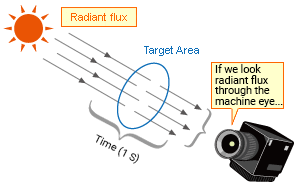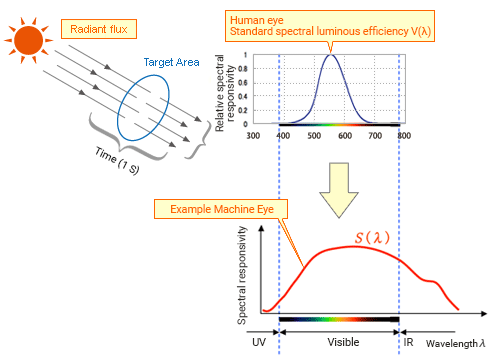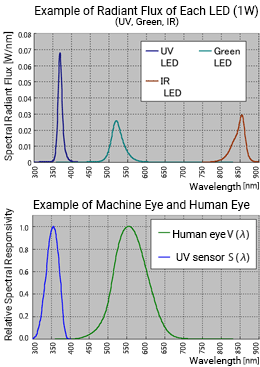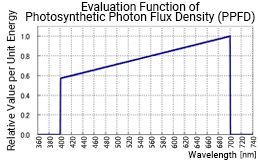Theory of Light and Color

5. Radiant Quantities and Luminous Quantities (Part 2)
Sensor Measurement Quantities
In the last chapter, we explained the relationship between the radiant flux, which is the basic unit of radiant quantities, and the luminous flux, which is the basic unit of luminous quantities. Although they share common geometric conditions, they differ in spectroscopic conditions. Luminous flux measures the perceived intensity of radiant flux (radiant energy emitted per unit time) according to the sensitivity of the human eye (standard spectral luminous efficiency V (λ)) under the same geometric conditions. In machine vision, which uses a machine eye instead of a human eye, this definition of luminous flux is not applicable. In this chapter, we will talk about measuring brightness through the machine eye as it relates to the human eye.
Radiant Flux Through the Machine Eye
How can we measure luminous flux through the machine eye? It may sound simple to replace the spectral sensitivity of the human eye with the machine eye. However, as explained in Chapter 2, there is no standardized measure for the machine eye as there is for the human eye (standard spectral luminous efficiency V (λ)) because there are various types of sensors for machine vision.

Machine vision sensors have different spectral sensitivity properties to suit the needs of various types of machine vision applications. Therefore, even when receiving the same radiant flux, different machine eyes have different levels of sensitivity.

The Relationship Between the Spectral Distribution of the Light Source P (λ) and the Machine Eye S (λ)
Consider three types of light sources: a UV LED, a green LED, and an IR LED. The area within the spectral distribution curve of the LED is the radiant flux, and the radiant flux of each LED is 1 W.
Compare the sensitivity of the human eye V (λ) and the machine eye S (λ) to each LED. The green LED is bright to the human eye since V (λ) is within the same wavelength band as the green. The human eye has almost no sensitivity to wavelengths in the ultraviolet and infrared range, so it feels invisible (dark) since it cannot perceive any stimulus from these bands.
In comparison, consider a machine eye with a UV sensor S (λ). The UV sensor can only receive stimulus from the ultraviolet range and thus feels bright to the machine eye, while the green and IR LEDs feel dark. Moreover, the brightness level that the UV sensor can perceive varies depending on the type of UV sensors since they have different sensitivity properties.

As shown by the above, it is theoretically possible to set a fixed spectral response and unit of measure if restricted to the use of a specific machine eye. For example, photosynthetic photon flux density (PPFD) is a unit of measure for applications in agriculture, forestry, and oceanography. ≪1≫ However, there is currently no standard for machine eyes in general machine vision applications. Thus, the unit of the brightness (stimulus) received by the machine eye is arbitrary, and only relative evaluation is possible under fixed conditions.
We can measure brightness relative to the machine eye in luminous quantities if the light's energy is in the visible spectrum and has fixed spectral distribution properties P (λ). However, it is not possible to measure relative brightness if there are lights with varying spectral distribution properties P (λ). Furthermore, for ultraviolet or infrared radiation, which does not have energy in the visible range, the brightness is zero regardless of spectral distribution without the use of a UV or IR sensor.
Although the above demonstrates the limits of evaluating light by using luminous quantities (measured in lumens), it is currently the most effective measurement system for machine vision. It is common practice to use an arbitrary unit to evaluate lights while setting the machine eye (camera) as a constant. ≪2≫
Summary
The last two chapters have described the relationship between the radiant quantities and the luminous quantities, using the radiant flux and the luminous flux as an example, and how they expand our way of thinking about the human eye and the machine eye. In the next chapter, we will talk about radiant quantities other than radiant flux and luminous quantities other than luminous flux.
Comment
≪1≫ Measuring light in photosynthesis
Photosynthetic organisms use light from 400-700 nm during photosynthesis. Photosynthetic photon flux density (PPFD) is the number of photons hitting a surface per unit area per unit time in photosynthesis. The units are [µmol (of photons) m-2 s-1]. There is a strong correlation between this range and the number of incident photons (see right). Therefore, a PPFD measuring device must have similar sensitivity properties.

≪2≫ Unit of measure for brightness through the machine eye
As described above, there is no standard measurement unit for brightness through any machine. However, it is still possible to measure relative brightness if the relative spectral responsivity S (λ) of the machine eye remains constant. In this case, the watt (W) is one possible unit of measure to represent effective radiant flux.
Although not the complete story, two parameters often used to describe the sensitivity of a camera or machine eye are the Quantum Efficiency (QE) and Read Noise (RN). The quantum efficiency of an image sensor equals the ratio of incident photons to converted charge, which is read out as a signal from the device. In other words, the QE indicates how efficiently the camera converts light into electric charges. It is a spectrally dependent parameter. The Read Noise (RN) of the sensor is the equivalent noise level of the sensor’s output in the dark and at zero integration time. A lower RN is associated with a more sensitive sensor. QE and RN together indicate the overall sensitivity of the image sensor expressed as QE/Read Noise, or the minimum amount of light you can see.

